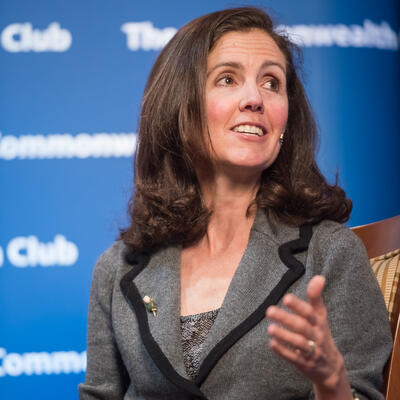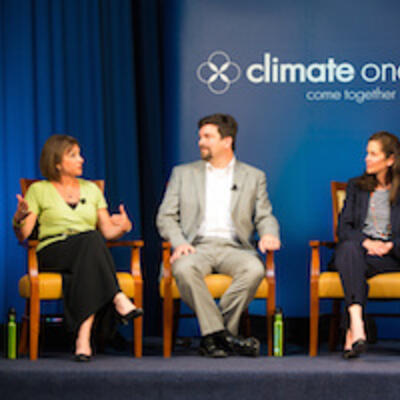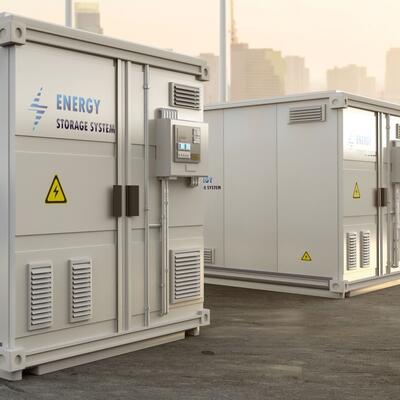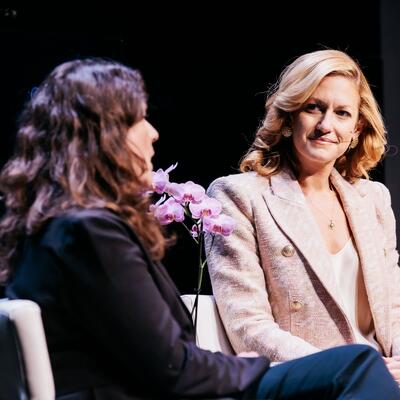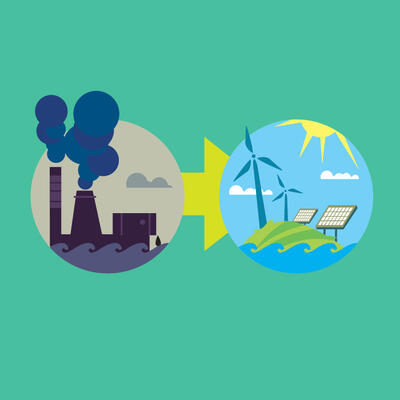
Going Carbon Negative
Guests
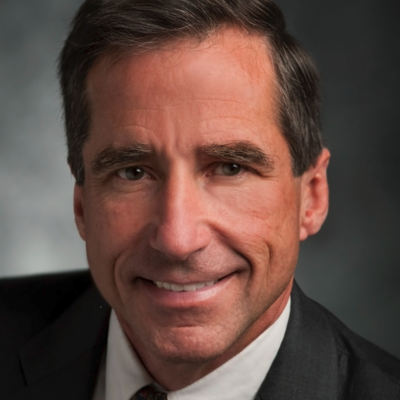
Mike Biddle
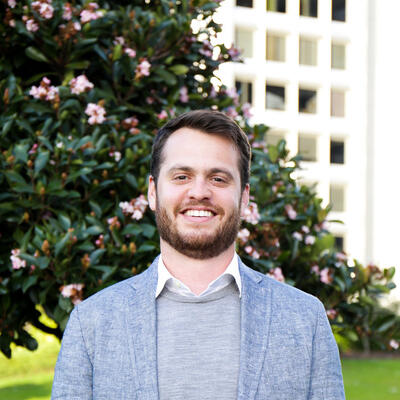
Noah Deich
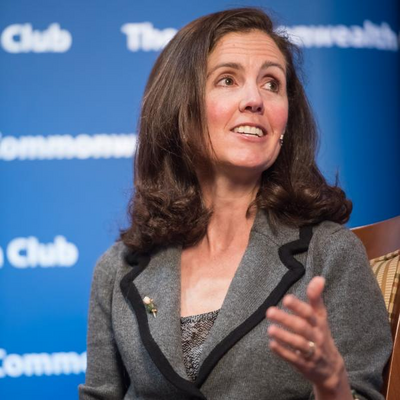
Diana Donlon
Summary
The math is clear: lowering greenhouse gas emissions is not enough to keep the earth below 1.5 degrees Celsius of post-industrial warming. The latest science states that actively removing carbon from the atmosphere — storing it in rocks, soil, trees, and even turning it into products like concrete — is critical to restore the carbon and energy balance. To keep our planet from dangerous levels of warming, we’ll need to go carbon negative. Which natural and technological approaches are the most promising? Three experts and host Greg Dalton discuss the necessary negatives for a stable climate.
Full Transcript
Announcer: This is Climate One, changing the conversation about energy, economy and the environment.
Diana Donlon: Humans have been degrading the planet for millennia but now we know better. And we know the consequences and we know how to fix it, which they didn't know how to do back then.
Announcer: It’s becoming ever clearer that if we hope to meet our climate goals, lowering greenhouse gas emissions is not enough – we’ve got to somehow reverse the damage we’ve done. Fortunately, modern technology has come up with ways to remove carbon from our atmosphere – and even put it to use.
Noah Deich: Once you capture carbon there is a wide range of things that you can do with it, whether it comes from a smokestack or the air or any other source. You can again turn it into an interesting product or you can bury it deep underground.
Announcer: Going carbon negative. Up next on Climate One.
Announcer: Carbon in our atmosphere. Is it friend, or foe?
Climate One conversations – with oil companies and environmentalists, Republicans and Democrats – are recorded before a live audience, and hosted by Greg Dalton.
Carbon emissions have been demonized – and arguably so – for their contribution to global warming. But Noah Deich of Carbon180 says carbon gets a bad rap.
Noah Deich: It’s not inherently bad, it’s just bad when it's in the atmosphere in too great of a quantity…if we can figure out through innovation how to turn that waste back into a valuable product we can take that liability and turn it back into an asset.
Announcer: Today on Climate One, we’ll hear about some of the ways that carbon can be captured and sequestered – in rocks, soil, trees and even in building materials and fuels. New technologies are leading the way – but that’s not the whole story.
Diana Donlon: Working with natural systems is not part of the conversation often enough and nature is far more powerful than we will ever be. And so if we harness these systems, you know, to our benefit instead of trying to work against them, then nature wants to be in balance, right, but we just need to create the conditions for that to happen - and we can.
Announcer: Reaching carbon negative status might sound as unlikely as unboiling an egg. But our three guests today say it can be done.
Diana Donlon is the director of Soil Centric, an organization that works toward regenerative agriculture. Mike Biddle is managing director of Evok Innovations, a clean-tech fund. And Noah Deich is executive director of Carbon180, a non-profit that champions carbon removal through science and innovation.
Here’s our conversation about going carbon negative.
Greg Dalton: Noah Deich, let's begin with you. The Supreme Court of the United States has said that carbon is a pollutant that should be regulated. How do you think it should be a friend rather than a foe in the climate story?
Noah Deich: That’s a great question and it's great to be here. I think the important thing about carbon is it’s not inherently bad; it’s just bad when it's in the atmosphere in too great of a quantity. So when I think about carbon removal I actually see the opportunity to take carbonates in the atmosphere where it's a waste it is a pollutant when it's there in excess. But if we can figure out through innovation how to turn that waste back into a valuable product we can take that liability and turn it back into an asset. And that's how we start all of our conversations on carbon removal is in that frame of innovation and economic opportunity to take a problem and turn it into an opportunity.
Greg Dalton: So for hundreds of years we’ve been basically taking it out of the ground putting it up in the air and we’ll get back to the ground piece. So what are some ways that we can put it into something useful into products that sort of thing, Noah Deich?
Noah Deich: So we can do a lot of things with it. On the technology side many of the products that we consume today are carbon-based we get them from the ground. But we can think about transforming how we make many of the products and materials in our built environment so that they come from the air instead. So this building cement, the timber products in the building all of that can sequester carbon. The fuels that we consume can come from the atmosphere. Even the clothes we wear and the food we eat can all be associated with carbon sequestration. So this is really an economy wide opportunity to think about turning carbon back into a value.
Greg Dalton: Okay, yes, the element like to hold hands in nature. Diana Donlon, there’s a book written The Soil Will Save Us it’s something that's gotten a lot of attention a lot of people can relate to. So how does soil come into this in terms of putting carbon restoring the carbon balance?
Diana Donlon: Sure. Well, you took the words out of my mouth I was gonna say what we need to do is restore the carbon balance because carbon as Noah said is always cycling through the system. And it’s actually the earth’s currency and in the atmosphere we have it in excess and it’s problematic but we actually at the same time have a deficit in the soil. And so many of our soils are hungry for carbon and Rattan Lal who’s the preeminent soil scientist on this planet was actually at the FAO yesterday which happened to be World Soil Day and he was talking about the opportunity to put the carbon back in the soil not only in the carbon sink that is the soil but also in the vegetation and we can get to those numbers later in the program about what the opportunity is.
But to Noah’s point too about timber and clothing and food, all that has its genesis in the soil. If you think of a tree, a tree, you know, think of a pine cone. That falls into the ground and that turns into a giant tree that’s just from air; that’s just all from photosynthesis. So we have a tremendous opportunity to work with these natural systems.
Greg Dalton: Yeah, some of the biggest optimists I meet in the climate conversations are the soil people who say put it back restore that balance. Mike Biddle, why are Canadian oil companies dabbling in this area?
Mike Biddle: I think for a variety of reasons. I think many of the oil companies around the world are starting to understand that they have to be part of the solution space and not just the denial space. I think I have my own opinions about Canada being a little bit more forward thinking than our own country so I think that plays a role. There is policy in Canada too that let’s say pushes them in that direction. There is a carbon tax in Canada that's been implemented. And I think that they're just looking for the future. They see the future of clean energy being different than it is today and they want to be prepared for what that future is they want to be a viable enterprise in the future. And I did the same with plastics I work with the plastics industry to solve a plastics recycling problem and the plastic in the oceans problem. And I think it's my belief that the industries that are part of the problem if you will need to be part of the solution as well. So I’m quite happy that they’re funding us to find solutions.
Greg Dalton: The ocean plastics problem hasn't really been solved yet, right. No.
Mike Biddle: It hasn’t.
Greg Dalton: Catch that once but you’re saying industry kind of comes in and perhaps in some relatively let’s be honest too some relatively small amounts of their capital outlays, right in terms of the capital expenditure the billions that these oil companies will invest. These are some pennies that they are kind of putting as hedges or a way to kind of learn so they're not surprised.
Mike Biddle: I’d say as a percentage of their revenues I think you could call it a small percentage. But in an absolute sense we’re one of the major investors in the space in fact we’re one of the few investors in the world investing in negative carbon companies. Early-stage risky companies two of them right here incubated in the Bay Area that are trying to take carbon out of waste streams like flue gas take carbon out of the air and that’s one case. And another company trying to take that carbon and as Noah alluded to turn it into new materials. There's not very many companies or investment groups on the planet willing to make those risky early-stage bets.
Greg Dalton: Anyone making money yet on carbon removal or using carbon as a -- Noah Deich.
Noah Deich: I know a handful are.
Mike Biddle: Okay, I’d like to hear that.
Noah Deich: I think --
Mike Biddle: I think they will but --
Noah Deich: I think they will too and where we’re seeing the first opportunities are in building materials. So figuring out how to turn CO2 back into cement for example, you can make a stronger, better product in many cases than what exists in the market today. So those companies are closer.
Mike Biddle: I think Carbon Cure for example, is probably the closest I’m not sure if they’re making money yet but I think they’re on a pathway to make money. So I think there are a few examples out there.
Diana Donlon: And some regenerative farmers are making money. So farmers that are using methods that improve their soil health if they’re starting with that and looking not at their yields but looking at the health of their soil they are actually -- there are five principles that you can that are universal which underpin soil health. And farmers that really study those principles and apply them like Gabe Brown who’s sort of the poster child for this in North Dakota they increase their soil carbon thereby increasing their fertility and their yields. So and they will show you their books and say, hey look, you know, and that’s their starting point they say we’re making money guys, so come on over to our side.
Noah Deich: And I think that the transformation is what matters right now not making money. We’re sitting here in the Bay Area where we have tech startups who 10 years in are still not making money and we deem them a wild success. We need to do the same thing when it comes to transforming all these industries not just our agriculture and food industries but also our oil, our manufacturing industry and the energy sector writ large. And so I think that's the right metric to think about how are we deploying capital and bringing these innovations to scale not necessarily will they make money right now.
Greg Dalton: Noah Deich, you told me about Occidental Petroleum which has a woman CEO, very unusual, and they’re talking about themselves in a different way. Tell us how Occidental is talking about their future in a different way.
Noah Deich: Well, so I think what we’re seeing from a number of players in the industry writ large is the realization that we can't continue business as usual forever. And not only that but the opportunity for transforming a business from one that's reliant on emission intensive activities into emission capturing and eventually sequestering activities can actually be really profitable. And Occidental Petroleum is different from some of these other oil companies in that they actually take CO2 and use it today at very large volumes. They're making oil with that CO2 so if you're thinking about it from a climate perspective it's a bit of a mixed bag.
Greg Dalton: So they're pumping CO2 into oil wells to enhance recovery.
Noah Deich: To get more oil.
Greg Dalton: To get more oil out, okay.
Noah Deich: Exactly. And so this is a very old practice at the end of the day, but it's one that's increasingly important when we think about the need to pump CO2 underground in large-scale in the future for negative emissions. And I think what we’re seeing is that at the end of the day, the amount of carbon that needs to go from the atmosphere back underground is similar to the amount of oil and gas and fossil fuels that we extract from the ground today and put up in the air. This is a huge industry; trillions of dollars. Billions of dollars of early investment is great but it's nowhere near the capital that’s gonna be needed for this transformation. And I think that's what we’re starting to see companies see today is they’re making money at a small scale now and they see that the future if they invest in it today at a real scale could be something that's incredibly large and prosperous for them and their shareholders.
Greg Dalton: So you see a role, a constructive role for the major oil companies in this transition rather than trying to stab a dagger in their heart and put them out of business.
Noah Deich: So the jury still out like we have to see how this plays out over time. The initial signs are encouraging. And I think we’re at the stage where everyone needs to be part of the solution. And I think what we’re seeing right now is real commitments from companies both in deploying their capital but also talking about their strategy to their shareholders about how in the future they will make this transition happen. And we’re really at the first leg of this marathon, but I'm encouraged that we’re taking the right initial steps today.
Greg Dalton: Diana Donlon, I've heard that if cows were a country they be the third largest global emitter. Tell us how cows can be part of the solution and, you know, grasslands in particular.
Diana Donlon: Sure. So in the United States we've lost 97% of what was our grassland prairie. And some historians would tell you that one of the reasons the United States is such a rich country is that we won the soil lottery as it were on this planet. And that when the glaciers came down the deposits of soil then grew up with the bison is synergy between the ruminant herds and this very deep rooted perennial grasses created this soil bank that we’ve been drawing from and so we only have 3% of that native prairie left. So if you think about the Serengeti, you think about, you know the Midwest and you think about different places in the world where there has been animal impact. We had the herds of zebra and all sorts of ruminants.
So grazing animals are not inherently bad, it is the way we, humans manage these animals. And right now, the way we have chosen as people to raise cattle is mostly in confinement. Now that has a lot of problems because the manure goes into lagoons and that creates methane and so on and so forth. The cattle which should be grazing on grass are fed corn and soy which is fossil fuel intensive to raise and which is not part of their diet which makes them sick and so then they have to be given antibiotics.
And so when people talk about cows being bad for the planet they are talking about the confined animal feeding operations. When animals are graze in a way that mimics natural herds moving through that’s actually beneficial. So we have to draw that distinction about the way the animals are managed. And some people see because we've lost these ruminant herds mostly in the world a great potential to mimic that what was nature going through with, you know, wildebeests or what have you and use cows as a proxy or sheep or goats.
Greg Dalton: So, free range cows are okay. Even though there's still methane coming out both ends of that cow.
Diana Donlon: Well, they have to be moved through a pasture in a very intentional way. So if you just put cows out on an acre and leave them there and come back a month later that’s not okay because the cows are going to go through and they’re gonna pick what they want and they might overgraze something and undergraze something else. What I’m talking about is a specific practice that has many different names and I won’t even get into them, but holistic planned grazing is more or less the catchall name for it. Where the rancher would move the cattle through a particular piece of land and then not come back to that land allow it to rest and recover. But that land has had some animal impact, the cows have reduced the fuel load by grazing it and they’ve also stimulated the microbial community and they’ve also fertilized it with their manure and not come back for two or three months, maybe even six or eight months whatever the time in is for that grassland to recover. That kind of grazing is actually climate beneficial.
Greg Dalton: Sounds expensive and takes more time and effort for ranchers to do that. Does that scale, ranchers a lot of them doing practices like they've been taught through the generations? It’s one thing to do that in a little boutique in West Marin but does it scale?
Diana Donlon: There are hubs around the world where it’s been tried and as long as, you know, certain principles are applied it seems to be working. I don't know enough about ranching myself to say the size of the herd but often the larger the herd from what I’ve heard is actually the easier it is for the ranchers once they adopt this method.
Announcer: You’re listening to a Climate One conversation about carbon removal. Coming up – we’ve captured it – now what?
Noah Deich: There is a wide range of things that you can do with it, whether it comes from a smokestack or the air or any other source. You can again turn it into an interesting product or you can bury it deep underground.
Announcer: That’s up next, when Climate One continues.
Announcer: We continue now with Climate One. Greg Dalton is talking about carbon capture and storage, with Noah Deich of Carbon180, Mike Biddle of the investment group Evok Innovations, and soil and climate expert Diana Donlon.
Here’s Greg.
Greg Dalton: Noah Deich, tell us, you know, there's different types of carbon capture. Tell us direct air capture versus smokestacks versus other types of things. Give us the portfolio if you will.
Noah Deich: Sure. So carbon capture is a broad umbrella term. It usually refers to technologies and these technologies essentially act as filters for either a smokestack whether that's on a power plant or an industrial facility like a cement plant or a steel refinery. We can also put carbon capture just directly in open air. This is called direct air capture. What's interesting about this wide range of carbon capture technologies is that it's applicable both for stopping additional carbon getting added into the atmosphere, but it can also be turned to take carbon that’s already in the air and getting it out. Once you capture carbon there is a wide range of things that you can do with it, whether it comes from a smokestack or the air or any other source. You can again turn it into an interesting product or you can bury it deep underground. Many people also talk about some of the natural solutions with in this carbon capture umbrella, natural carbon capture being trees and plants that capture carbon through photosynthesis and lock it away in forest or ecosystems or soils. But I think when we hear carbon capture and storage it usually is referring to the technology options on the table.
Greg Dalton: And then the carbon math, you know, some of the latest reports come out it’s like 12 years or so before we’re gonna go through the carbon budget to have a chance of avoiding more than 2° of warming that sort of thing. So to get there is carbon capture going negative gonna be necessary and are these technologies ready in time to when they’re really gonna be needed; break the glass, they’re needed.
Noah Deich: Sure. So there’s a lot of issues with that framing in my mind too because there is not a point at which climate change either happens or it doesn't we’re already seeing it today. And so what we need is every solution that we can put on the table as quickly as possible, because every even 10th of a degree matters at the end of the day. And so that's why it's so important to figure out how we get carbon capture in all of its forms, both the natural the technological and within the technology umbrella industry power and through the direct air capture routes that we need everything that we can have.
Greg Dalton: Diana Donlon, are big food companies getting involved in this? It’s one thing to have, you know, some ranchers here and there but what about the sort of the industrial food giants are they getting involved in paying attention to soils and this?
Diana Donlon: They are. They’re concern about their supply chain because when you have, you know, hurricanes and when you have these extreme weather events you have this oscillation between flooding and drought that disrupts supply chain. So one of the big players General Mills which is an enormous conglomerate recently bought 63,000 acres of land that they are farming organically and they have extension agents actually helping the farmers use best practices in terms of soil health. So like cover cropping and keeping a living root in the soil and so forth.
And then they are able to sell the wheat that they grow on this I think is in Montana, it’s either Montana or Minnesota where they bought the 63,000 acres and sell that at a premium. Another company that I can think of that’s not a large company but it’s an important one in my book, it’s a chocolate company, Alter Eco, they are working with carbon insetting. So typically cocoa is grown in monoculture where you’re just having the cocoa trees and nothing else. They’re using agroforestry which is a very promising natural solution to climate change and it’s multistory and then they’re actually putting more carbon back into the system than they're taking out. So we get chocolate and we get extra carbon. Groups like that.
Noah Deich: Yeah, I think the interesting thing that we’re seeing for a lot of this food and ag companies interested in these carbon sequestering solutions is they're not looking for the carbon to drive the business case. In many cases they're interested in the resilience of their supply chain or some other ecosystem benefit whether that's water or the amount of fertilizer that needs to get applied or even the yield of the system. And it's interesting because we don't, when we think about climate change we’re always thinking in carbon how much carbon is sequestered and how do we value that. But what we’re seeing is industry at least in the food and ag side is really thinking beyond what value we can get from carbon and these businesses are being driven on the full basket of benefits that many of these solutions can bring.
Greg Dalton: Mike Biddle, what have you seen under the Trump administration in terms of the Department of Energy, support for energy research, that sort of thing. I know Congress actually in some cases gave more money to certain energy development -- advanced energy then was even requested under the Obama years.
Mike Biddle: Yeah I guess many of us in the space have been concerned about what the administration is going to do to support our efforts because early-stage investors like ourselves have largely depended on research labs out of universities, much of that research being sponsored by U.S. government grants, to de-risk the technology to try out everything under the sun because I completely agree with Noah we need every single tool in the toolbox and we need a bigger toolbox to solve this multifaceted problem. And so we've been very concerned that that funding and that funnel for us to be able to get technologies out of laboratory so that we can turn them into companies that can then solve these problems was going to start drying up. But just this January many of us were at ARPA-E Summit, ARPA is the Advanced Research Projects Agency –Environment. They are modeled after DARPA which has been a very successful government funding model for defense-related technologies.
Greg Dalton: And the Internet.
Mike Biddle: And the Internet many things that we take for granted every single day. And we felt there was a kind of a gloom and doom January this year at the ARPA-E Summit because we were certain that their budget was gonna be slashed. It turns out their budget was increased as you suggested. DOE’s budget has been increased for clean energy and we’re already seeing the fruits of those budget increases. Several of our early-stage companies have received multi-million-dollar grants to help the rest the technology. And without that many of these companies would simply not survive.
First, they wouldn’t get out of the laboratories; they wouldn't get to a state to where they would be investable by even early-stage investors like ourselves. We then prep them for larger investors down the road and then usually at that point they’re ready to be adopted by large industrial organizations whether it be in the chemical industry, oil and gas industry, the automobile industry.
Noah Deich: I just think the amount of funding overall, is just a tiny, tiny drop in the bucket.
Mike Biddle: It is.
Noah Deich: And it's nowhere near what’s needed.
Mike Biddle: We can say that about the entire space these billion-dollar funds are a good start, right. Our fund is a good start and you have to start somewhere.
Noah Deich: But DOE spends billions of dollars a year on clean energy research. The amount that they have spent ever on direct air capture that we've been able to identify is 5 million, that’s it. They doubled the carbon utilization budget to 10 million in this one. So as a percent increase that's fantastic but when we see recent reports coming from the national academies that say we don't need millions we need billions of dollars a year across this full portfolio not just DOE but USDA and other science funding agencies we’re nowhere near where we need to be to get on track when it comes to that research and development portfolio.
Mike Biddle: I mean I think I'm glad you raised, I mean we’re here talking about negative carbon and carbon capture from air has to be part of; it's a big part of that discussion. Trees do it extremely well, but they just don't do it fast enough; we can't plant enough trees to make a dent. And unfortunately at least the technologies today are so far from being economically viable that I think it's difficult to justify big investments in there. I'm probably making your point for you hence, we need to do more to drive that price down. But it's an extremely difficult space to try to figure out that carbon is so dilute in the air we breathe. Four hundred parts per million is making a huge difference in the climate that’s why we’re here today. But it’s so dilute the technology and costs associated with pulling it out of the air is extremely difficult.
Noah Deich: Yeah, but it's not that challenging at the end of the day.
Greg Dalton: So technically simple but is the cost of problem or technology?
Noah Deich: So plants don't complain that CO2 in the air is only 400 parts -- it’s too cheap to meter for them, right. And so I think they've had a few hundred million years of R&D, I’ll give you that but what I think that we’re seeing is that we haven't started this. Spending $5 million total on anything is like where we were with solar back in the 70s. That there were a handful of solar panels on NASA missions but what we've seen over the past couple of decades at this point is billions of dollars going to the research and then more importantly billions and tens of billions of dollars go into the commercialization of those solutions. We’ve seen the price of solar drop a hundred x; I think there's a reason to see that we can bring down the cost of direct air capture and other carbon capture technologies maybe not a hundred x but definitely in order of magnitude. And that’s really something that could be a game changer in this field.
Diana Donlon: And restoring soil health is really inexpensive and can be done globally and at scale. So if we consider the size of the opportunity 50% to 70% of our cultivated soils are depleted, which means we could put soil carbon back in through photosynthesis to 50% to 70% of our soils globally. So what does that entail? That entails keeping, you know, that’s composting that’s just returning the organic matter from whence it came. That means leaving some sort of mulch over your soil; don’t let it be exposed to the elements so it keeps the microbial life alive, which means the trees will grow faster.
Greg Dalton: So that means no raking and blowing which a lot of what --
Diana Donlon: You really shouldn’t rake and blow. No, no.
Greg Dalton: Let’s get this down to the backyard, you know, a lot of that is just vanity, right.
Diana Donlon: Well but there are consequences to that raking and blowing because when you do that you’re leaving -- the soil is like the earth’s skin and that’s what makes our planet unique is we have a living soil ecosystem. It is alive and climate scientists can see that almost like, they can almost see it breathing. They can measure it when they see the northern forests draw down the atmospheric carbon in the spring. So when you take away that cover what you're doing is you're allowing the water to go back up into the atmosphere and what happens is the reason our state burned so badly is it is as dry as a piece of toast because the soils lack carbon, water follows carbon. If you increase soil carbon by 1%, this is Natural Resource Conservation statistic, so 1% in the top 6 inches of topsoil you're holding capacity on an acre of land is 27,000 gallons of water. So if you are exposing your soil constantly to the sun and the wind and the heat and it’s drying it out, all that moisture is dissipating and so when fire comes through you don't have that sponginess. We have a dry sponge where we should have like a moist sponge. So I just want to broaden the conversation just a little bit because soil is one of these sort of we all talk a lot about water in the atmosphere and so forth and soil is something that we really take for granted.
But for food security, water security for our medicines for so much, we absolutely rely on it for decomposition and yet we are abusing it and we could work with it and really cost effectively. And so that would help alleviate poverty we have all these millennial goals that the UN has put forward. We’re never gonna meet them unless we put some of that back in to vegetation and soil.
Noah Deich: Yeah, and I’ll agree that the potential of soil is enormous. All of these co-benefits that you talk about are real in many of these cases. The challenge is how do we get this to scale quickly and that when researchers look at the numbers associated with soils and forest Mike does have a point that you can't increase all of the carbon in the soil that has been lost over centuries of agricultural production in the time frames that we’re looking at here. So this actually become something that’s very challenging to do at scale. We should absolutely get started and it's a no regrets strategy. But I also don't want to make it seem as if it's very cheap and very easy because there are enormous hurdles when it comes to transforming our agricultural sector to actually unlock all of those benefits.
Diana Donlon: Sure. No, nothing is gonna be easy. But in terms of cost and, you know, knowing that it's a proven and safe technology with co-benefits instead of with some unknown consequences that could be detrimental. And since we know that even if we didn't have a climate problem we would still need to feed this growing population and we would still need fresh, clean water. And, you know, we would still need all these other things so we can incentivize these other sectors that are beyond climate. The water sector, you know, the food security sector, you know, for peace and security.
I mean the reason people are fleeing their homelands it's violence but what precipitates that violence, it’s when, you know, Tom Friedman had a big column about this, you look at Syria they had years of drought and they had failed harvests. So then you have war and then you have migration.
Noah Deich: I just think it's not a unilateral solution. I think the first rule of improv, yes and makes a lot of sense when it comes to the solutions. And I think a misconception with a lot of the technology strategies is that they actually are fairly proven. We have been capturing carbon sequestering it underground for decades. We know how that works. And so I think that we actually have a basket of solutions that if we deploy together can be complementary and reinforcing and get us where we need to faster.
Diana Donlon: Absolutely. But my point is that at the Governors’ Climate Summit, they had a hashtag which was nature the forgotten solution sort of working with natural systems is not part of the conversation often enough and nature is far more powerful than we will ever be. And so if we harness these systems, you know, to our benefit instead of trying to work against them, then nature wants to be in balance, right, but we just need to create the conditions for that to happen and we can.
Noah Deich: Sure.
Greg Dalton: Mike Biddle.
Mike Biddle: Yeah, I think we’re in aggressive agreement up here that we need every tool in the toolbox there’s no single category that’s going to solve the problem I think that's really important. And we have I think a lot of environmentalists and NGOs are I think rightly concerned that when a solution gets promoted to the public as being the be all and solution they say okay we’re done. And no, we’re just scratching the surface.
One metric, I wanna come back to the air carbon to kind of maybe frame how much work we need to do in this area to make a dent.
So one of the companies that Noah works with is Climeworks over in Switzerland on air capture and they’re one of the leaders in the world on air capture and they've actually have a few systems deployed mostly putting CO2 in greenhouse gases and they've got a few other use cases now as well. If you go to their website they make a claim that they want to by 2025 I think it is, deploy enough systems to capture 1% of the global emission, CO2 emissions. 1% doesn't sound like a lot, but it's a very big number. They would need 750,000 SeaLand containers full of their equipment to do that work. That sounds like an impossible dream, but that's the number of containers that go through I think it's Hong Kong Port in just two weeks.
So okay, first it sounded undoable. Now it sounds doable again. And the space required for them to capture the amount of CO2 their equipment could capture if you wanted to do the same with agriculture or trees you need 1000 I think times the space roughly. So we simply don't have the space -- we need to do everything we can to make the earth do a better job of capturing the carbon it's doing it every day, day in day out but we can improve on that. But there's not enough surface area on the planet and we need that to turn it into systems that will simply take CO2 out of the atmosphere. So we do need these engineered solutions in addition to doing a better job helping mother nature do a better job and stop hurting mother nature doing the job.
Announcer: You're listening to a Climate One conversation about carbon capture solutions. Coming up, finding hope – right under our feet.
Diana Donlon: When I learned about the soil carbon opportunity, I thought, how do I not know this? First of all, I’ve been in this business 20 years and nobody has ever mentioned soil before. [:12]
Announcer: That’s up next, when Climate One continues.
Announcer: You’re listening to Climate One. Greg Dalton is talking about going carbon negative to reach our climate goals. His guests are Mike Biddle of the cleantech fund Evok Innovations, Noah Deich of Carbon180, and Diane Donlon of Soil Centric.
Let’s hear more of their conversation.
Greg Dalton: We’ve been talking about kind of abstractions, you know, sucking carbon out of the air. I wanna bring this to kind of a more personal human emotional level. Diana Donlon, about 10 days more than 7 million Californians were breathing smoke from a climate amplified fire. I've been gazing at climate impacts for a long time. I never thought that I would have to ask my teenage daughter, honey, do you have your mask before you walk out the front door because of the smoke of a fire hundreds of miles away. So tell us how that fire affected you, you know, as someone who thinks about climate a lot. How did that affect you?
Diana Donlon: It’s terrifying. I mean it’s terrifying for all of us, wasn’t it? And one of the ironies is that I know two people that lost their homes up in Butte County and one of them a guy named Chris Kirsten works with the Savory Institute and he is working to promote solutions all over the world. He lost his dog, he lost his house; fortunately his wife and children were okay but, you know, it’s really traumatic. So I was thinking a lot about them but when you realize how dry everything is and how the soil sponge has just been rung out it’s not surprising. So we really do need to work with these systems because when fire cons we are, you know, we’re pretty powerless and that was demonstrated.
Greg Dalton: Noah Deich, you’re a young guy embarking on a career in this. I was sitting on this stage a few days ago with someone from Cal Fire saying there's more of this coming, gonna be a lot more of this in your lifetime. How does that, you know, sit with you couple weeks afterwards the prospect of more of these fires?
Noah Deich: Well, I can resonate with it feeling powerless to make change, but I think one of the bright spots when you think about sequestering carbon through all of these natural systems is all of a sudden we can turn what is one of these imminent challenges into opportunities for solutions. So if we figure out how we can manage our forest better we can reduce our fire risk and sequester carbon. Sometimes that carbon can be taken out of forests and put into buildings where it gets locked away for centuries displacing the cement or other emissions intensive materials. And so we get all of these cascading impacts so we’re not just helping to mitigate fires in the future but also turning it into economic opportunity in these places that have just been devastated by some of these natural disasters.
Greg Dalton: Noah, do you ever have resentment toward the boomers who kind of trash the place?
Noah Deich: Oh yeah, it’s definitely their fault. No, but I think we can all be part of the solution. And I think that's the great part of this whole conversation is it doesn't matter where you are; there’s a solution that you can participate in. If you can’t ride your bike you can figure out how to buy food that is sequestering carbon and you don't necessarily have to commit your career to this, but there are so many opportunities and there will be in the future that I think this is just an exciting place to be even though we’re in such a -- the hand that we've been dealt is really tough.
Greg Dalton: Diana Donlon, do you ever get different fake hope like there's a lot of people think you can't say how bad it is. Don't tell grandma how bad it is because she’ll, you know, she’ll get better faster if you lie to her a little and say you’re more optimistic than you really are.
Diana Donlon: Well I’m just a natural optimist and I’ve been, this has been my whole career has been working on environmental issues. And initially I worked for the Goldman Environmental Prize and I’ve studied all these different issues. And I thought okay, we have to work on mangroves so we have to, you know, work on rainforest or whatever it was and then all of a sudden sort of midway through I was like, oh wait, climate, this is the biggest one and that was a little daunting and quite depressing.
But when I learned about really about the soil carbon opportunity, that gave me tremendous amount of hope because I thought how do I not know this first of all, I’ve been in this business 20 years and nobody has ever mentioned soil before. And I was part of all these food system groups and nobody had ever talked about soil and I thought if I don’t know this, there are a lot of people that don’t know about this. And then I would recommend a book to you called Dirt: The Erosion of Civilizations, which really talks about how erosion and deforestation and so forth how it’s happened through millennia. I mean there are conversations between or concurrence between Plato and Aristotle saying, you know, erosion is a threat to the Greek civilization. And then da Vinci talked about the soil ecosystem, Darwin, his last book was on earthworms, he spent 40 years studying earthworms.
So there have been this, you know, it didn’t happen, I mean when you start feeling guilty humans have been degrading the planet for millennia but now we know better. And we know the consequences so we kind of, you know, hit the end of the road and we know how to fix it, which they didn't know how to do back then. So I don't think we can absolve ourselves; we just have to put all the tools and, you know, get to work.
Mike Biddle: One analogy quickly that I have been in some talks with sometimes because it always comes up that, you know, government needs to fix this, big companies need to fix it, the oil and gas industry needs to fix it. And the answer to all that is yes. But I did a few calculations that I like to share with people, I will share this really quickly.
So I calculated that Unilever which is considered to be one of the most forward thinking companies on the planet trying lower its carbon footprint, the CEO came in and said we’re gonna double our production but we’re gonna halve our carbon footprint at the same time. They reduced their carbon footprint by a million tons over I think was a 4, 5-year period. I divided that by the number of employees per year and it worked out to be one ton per year per employee. That’s not bad for changes that they made in their company while they were still growing the company over that time period. I did it for our family. Solar, riding bikes going vegan for the most part. Did that calculation, we were 5 tons per year. So small changes --
Greg Dalton: Per person or --
Mike Biddle: Per person.
Greg Dalton: Five tons per person. Better than Unilever.
Mike Biddle: Five. So 5 x what Unilever did with billions of dollars of investment, we just changed our lifestyle. I’m not saying that you need to do that, we made three small changes, that was it. And that was a bigger impact than multibillion-dollar companies who roll out huge programs have made. So individuals can have bigger impact --
Greg Dalton: Mike Biddle. Yeah, let’s give it up for Mike Biddle, right.
Mike Biddle: My message is what each of us chooses to do every single day of our life can have a bigger impact than pointing at the big government or big companies to solve the problem for us. We can make the difference.
Greg Dalton: If you’re just joining us, we’re talking about carbon capture and storage at Climate One. I'm Greg Dalton. My guests are Noah Deich, head of Carbon180. Diana Donlon, an expert on restoring soils and Mike Biddle who runs an investment firm backed by some oil companies.
Greg Dalton: Let’s go to audience questions. Welcome to Climate One.
Male Participant: Hi, I’m Felix Kramer from Healthy Climate Alliance. I'd like to ask a question about the scale of all this. There seem to be two conversations going on about carbon removal and there's the ones that talk about in the Paris agreement every scenario involves some carbon removal. And there's another conversation that really took off when Drawdown came out a book with the title how to reverse global warming, not slow it not get to 1.5, but to remove enormous amounts of carbon in the trillion ton range.
So I'm wondering if you can talk about the solutions you see in the context not of the let's try to avoid the worst consequences of climate change, but let's fix the problem. Are there solutions that could do 10 or 20 billion tons a year by 2050 and what should we be doing to encourage those?
Greg Dalton: Amp up the ambition. Noah Deich.
Noah Deich: Yes, so I think what you're really looking for is what portfolio of solutions can get you there. And I think within that portfolio a number of big ones have been identified. The simplest ones are our trees and our soils these are technologies that are ready to go and can get to that billion ton, if not larger scale per year. When we’re talking about going beyond that we likely need to have technology options. And these are things like direct air capture machines filter CO2 directly from the air or various ways to essentially grind up rocks that react with CO2. The scale potential is not really the question in my mind; it's the what's the economic potential and our willingness to pay for all of these solutions. We can do this technically, it's just a matter of can we innovate and implement the markets and incentives to actually do this at the billion ton scale, let alone the 10 billion ton scale.
Greg Dalton: Thank you. Next question.
Male Participant: Okay, Tom McGowan. I'm from Albany, California. I’m involved with Citizens’ Climate Lobby. The question I have is if there is a carbon tax or fee and dividend, how does that play into this? Because suddenly now taking carbon out of the atmosphere, the carbon has more value than it would've, and is that going to incentivize or give it a financial incentive or is it really neutral to what you're trying to achieve in these different areas?
Mike Biddle: No, it’s huge, it’s night and day. It would make an immediate difference; nothing moves faster than free enterprise. You send a pricing signal to the market, entrepreneurs will come out of the woodwork to jump on the opportunity.
Greg Dalton: But most of those investors don't want to make policy dependent investments, right. Because they don't think government, they don't like betting on government so they don’t make policy bets, right?
Mike Biddle: I agree. I guess, you know, I’ll beat the drum, I mean a lot of people have said we need a carbon tax, I mean the audience is big on that. To me it's about pricing externalities. I had the same problem in recycling plastics. It is a cost. We want the truth at the end of the day. The truth is carbon has a cost on every single one of us on every dimension of our life. And if we don't cost it we’re being foolish, we’re being shortsighted, I mean, I think everybody in this audience knows that. The trouble is there's a lot of part of the population that coin hasn't dropped yet.
Noah Deich: Yeah, but design matters to the question though. We can design carbon tax in a way that will incentivize these solutions specifically and we can design one that's less favorable to it. It's just a question of them implementation.
Mike Biddle: I think there's been some great examples, you know. Give the money back to the people and let them, you know, and if you're a low carbon you're not going to be -- you’re not gonna feel that tax if you live a low carbon life.
Greg Dalton: Let’s go to our next question. Welcome.
Female Participant: Hi. My name is Erica Dodds. I’m with the Healthy Climate Alliance. I really appreciated the discussion about the potential of natural systems to draw down carbon and I was wondering if any of you could speak to the potential of photosynthesis and carbon drawdown in our oceans.
Greg Dalton: Oceans, we've overlooked. That's where a lot of it goes. Noah Deich.
Noah Deich: Sure. So I think that there are opportunities especially around coastal ecosystems that make a ton of sense again. They have lots of benefits and as we think about how do we adapt to changes in climate already underway, mangroves and other coastal ecosystems can be a great buffer for increasing storms.
I think where the science is weakest, however, is how do we do something in the deep ocean, how to reduce that at a large scale in a way that we actually understand what the carbon balances are and that conform with our protocols about how we deal with open ocean interference. So I think right now it's an important area for science, but it's not something that's really ready when we think about very large scale to get started on.
Greg Dalton: Let’s go to our next question. Welcome to Climate One.
Female Participant: Hi. I’m Megan Kygo, San Francisco. So there’s a lot of solutions talked about in your guys’ panel discussion about to what we need to do to like work with nature, private versus public sector to what degree we should be coordinating as a global community and things like that. I was just wondering to what degree do you think we can measure each of these solutions in relation to each other. Because on the one hand, like it's really great that each of us like through lifestyle changes can like, I don’t know, save five tons of carbon, things like that and not to say any of these solutions are exclusionary, but to what degree do you think we should be trying to like measure each of these solutions in relation to one another in terms of prioritizing, which is most effective, what combination of solutions are effective and to what degree is that even like a worthy amount of time we should really like spend on it.
Greg Dalton: Thanks. Mike Biddle, sounds like you went through this process.
Mike Biddle: Oh, it’s a great question. Thank you for asking it and you nailed it, and we have to get the answer right. We have to know what the true cost is on many dimensions. There's tools like lifecycle analysis, lifecycle assessment that are being deployed. Someone mentioned project drawdown which was started by Paul Hawken, a Bay Area native.
I would direct you to that book if you're not familiar with it because it tries to do that. It tries to put things in perspective. And I would say a lot of the solutions in that space are surprising and they involve people changing behaviors that can have a big impact again to some of my earlier comments.
Diana Donlon: So one of the potential levers in project drawdown is empowering women and girls. And if we do that globally that actually has a huge climate benefit. And most of the subsistence farmers in this world are now women. So we empower, you know, if that is what you wanna do, that will have a climate impact. So you kind of have to look at it as an equation, you know, we do this plus this plus this plus this and then we get there.
Announcer: You’ve been listening to a Climate One conversation about the promise of carbon removal. His guests today were Noah Deich, Executive Director of Carbon180, Diana Donlon, Director of Soil Centric, and Mike Biddle, Managing Director of Evok Innovations
To hear all our Climate One conversations, subscribe to our podcast at our website: climateone.org, where you’ll also find photos, video clips and more.
Greg Dalton: Climate One is a special project of The Commonwealth Club of California.
Kelli Pennington and Sara-Katherine Coxon run our audience engagement.
Tyler Reed is our producer.
The audio engineers are Mark Kirchner and Justin Norton.
Anny Celsi and Devon Strolovitch edit the show.
I’m Greg Dalton the executive producer and host.
The Commonwealth Club CEO is Dr. Gloria Duffy.
Climate One is produced in association with KQED Public Radio.
Climate One is presented in association with KQED Public Radio.
